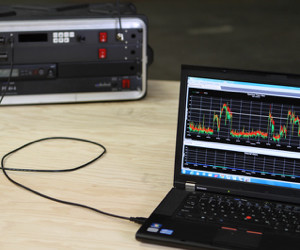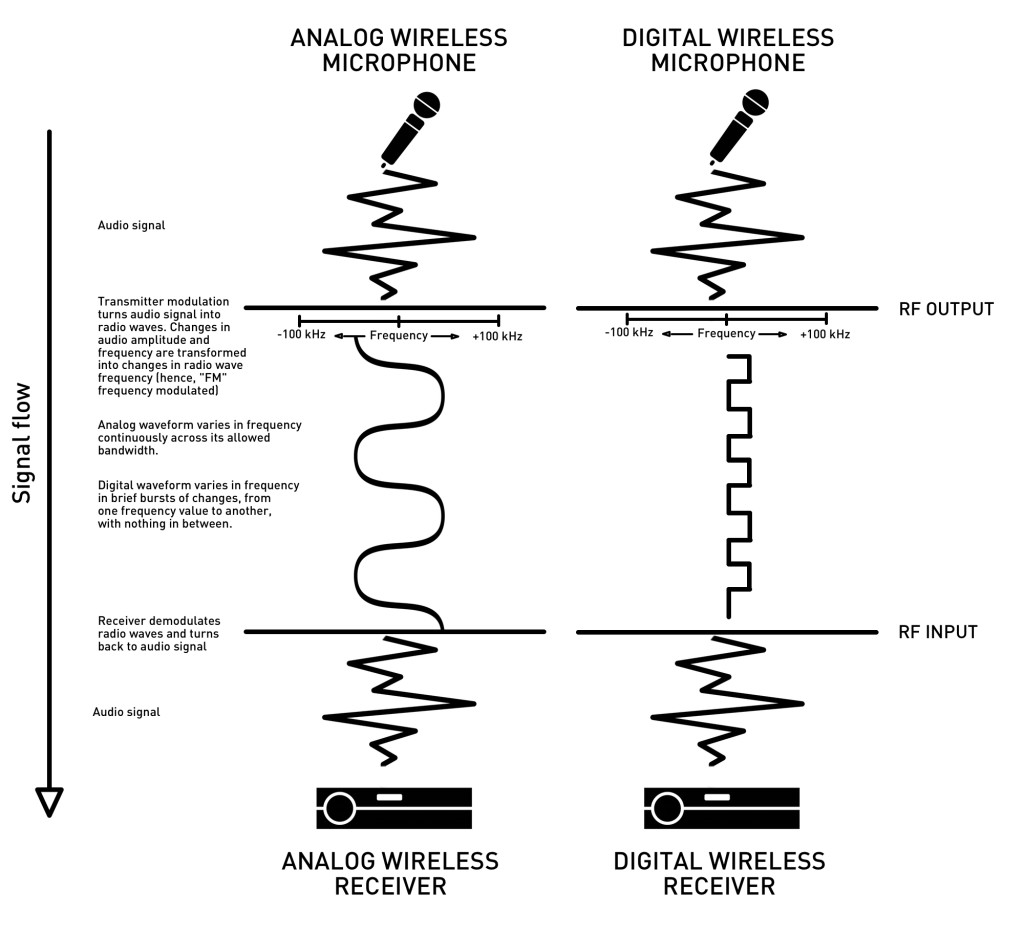The Case for Digital Wireless Microphones
Digital wireless microphones sometimes get a bad rap. Early models, especially those operating in the 2.4 GHz band, did not sound as good as analog and were beset by dropouts and interference.
Combine that with a general preference for “analog” products among your average audio engineer, and many live sound professionals tossed digital wireless under the bus before it had time to mature.
This is a shame, because today’s digital wireless microphones offer performance specifications that satisfy the needs of most end-users, and offer one advantage that is critical to the future of wireless audio: spectral efficiency.
What is a digital wireless microphone?
First, I want to make sure the difference between an analog and digital wireless microphone is clear. The real difference between analog wireless and digital wireless is in the way the radio wave behaves.
Digital modulation creates an radio frequency (RF) waveform which has discrete, “quantized” values. We usually think of only two options—on or off, one or zero—but in practice digital modulation schemes may have multiple values. An individual carrier wave abruptly switches from one frequency to another, or from one amplitude to another, in predetermined patterns that communicate audio information to the receiver.
By comparison, a radio wave that uses analog modulation changes frequency in a way that is directly proportional to the varying nature of the electrical signal that the modulation circuit is fed. This type of radio wave is in a state of constant variation. All analog wireless microphones on the market today are frequency modulated (FM), though amplitude and phase modulated radios are used in other industries.
Sometimes, professionals are confused about the term “digital wireless microphone” because because it can bring to mind a different application of digital technology. Just because a microphone uses the word “digital” in its title or product literature does not mean the RF is digital. There are wireless microphones that digitally sample audio or incorporate digital signal processing (DSP) prior to radio modulation, but actually transmit an analog waveform over RF frequencies.
This distinction is misunderstood often enough that it bears some repeating: Wireless microphones on the market that incorporate A/D converters or other digital stages before the transmitter sometimes use analog wireless technology, not digital wireless. Most thorough specification sheets should have a “modulation type” field that will clarify whether your model uses digital or analog FM.
It is also worth clarifying the difference between “UHF” and “2.4 GHz” digital. Today, manufacturers offer more digital wireless systems than ever before, and they are no longer dominated by systems operating in the lower frequency UHF band (470-698 MHz). In recent months, 2.4 GHz systems like the Line 6 XD-75, Shure GLX-D, Sennheiser Evolution D1, and AKG DMS tetrad have overshadowed UHF offerings. Of the digital UHF models available, the Shure ULX-D is probably the most familiar.
There are important differences between 2.4 and UHF digital. 2.4 GHz systems sound good and are easy to set up, but the crowded nature of the 2.4 GHz ISM band (shared with WiFi, bluetooth, and many other devices) means that fitting more than 10 channels into this band is difficult.
Why should you care?
Now that we’re clear on what a digital wireless microphone actually is, we can talk about why they are useful.
Next year the FCC will attempt to repurpose a large amount of the UHF broadcast band for mobile services. A large percentage (no one knows exactly how much) of current 600 MHz, and possibly 500 MHz spectrum, will no longer be available for microphones, while the remaining spectrum will be thick with repacked TV stations and and “white space devices” or WSDs.
Though users will have up to 39 months to vacate repurposed airwaves after the FCC sells off this bandwidth through “incentive auctions”, the situation in remaining spectrum after that time will be dire. In these crowded frequency bands, ”spectral efficiency” will be more important than ever. Tools that maximize the use of the available wireless spectrum will be essential, especially for those who need to operate multiple channels. To those ends, digital wireless is one of the most powerful and widely available tools at our disposal.
Digital wireless is more efficient largely because the carriers used in digital signals have less prominent harmonic “sidebands”. This allows users to pack many more channels of audio into the same available bandwidth.
Analog FM signals are flanked by comparatively loud sidebands that carry no useful information. When multiple analog systems are used in the same area, these sidebands interact with neighboring devices to produce cross-modulation or intermodulation products, often called “intermods” or “intermodulation distortion” (IMD). that require adjacent signals to be spaced relatively far apart.
With digital systems, the wave is generated with fewer intermediate steps and so produces a signal with a far thinner sideband “skirt”. Because they lack the significant sidebands of analog FM technology, digital transmissions are less likely to interact with one another to produce harmful IMD. Using high-quality digital wireless microphones, operators can (almost) disregard the IMD concerns he or she would have with an analog system, and pack channels right next to one another.
Steve Caldwell, who is perhaps best known for his work coordinating wireless frequencies for the Olympics, recently told me he will fit more than 40 channels of Shure ULX-D microphones into a single TV channel for an upcoming international event—something that would be impossible with analog.
Digital wireless does have a few disadvantages. Latency is one of them, though I have not seen a professional grade digital system with latency over 4 milliseconds. Another is resistance to interference. Since a digital transmitter’s energy is distributed over multiple carriers (rather than a single carrier) digital will have a lower signal-to-noise ratio at the receiver than an analog system would under the same conditions. That’s why coordinators like Steve Caldwell still prefer analog over digital for critical channels or under conditions where the noise floor is high.
This second point is an important consideration for operators who are responsible for “supercritical” performances, where every slight advantage in noise floor counts. But for the average small venue gig, school installation, house of worship, or corporate boardroom the noise-floor will be sufficiently low to safely operate a digital microphone, which in turn opens up additional spectrum for other devices throughout the facility or in adjacent buildings.
In urban areas, college campuses, corporate offices, and other locations where multiple wireless microphones must interoperate in close proximity, A/V professionals can sow reciprocal, population-level benefits for everyone in the immediate area. Each analog mic forgone in favor of a digital one frees up spectrum in the same area that can be used by someone else.
Choosing equipment based on its impact on other users may not be something we are accustomed to thinking about today. It may even seem unnecessary while spectrum is still plentiful and our existing analog devices work just fine. But after the auction, our thinking may need to change.
Please note: When you buy products through links on this page, we may earn an affiliate commission.










Dave Agr
April 4, 2016 at 10:49 pm (9 years ago)great article, I have a question, I want to buy a wireless system for use in a church setting, I am interested in the sennheiser ew (analog) or sennheiser ew D1 (digital) what would be better?